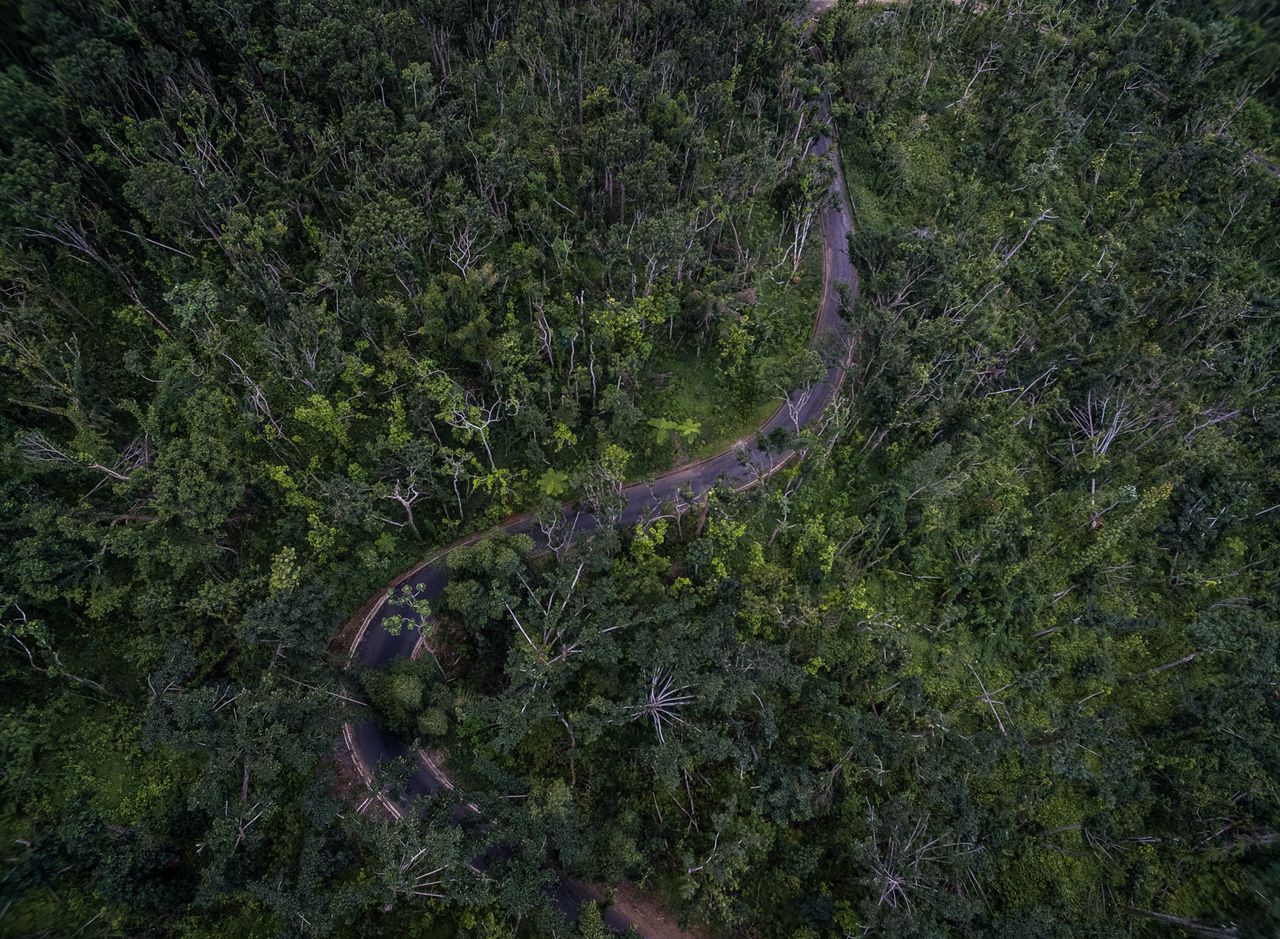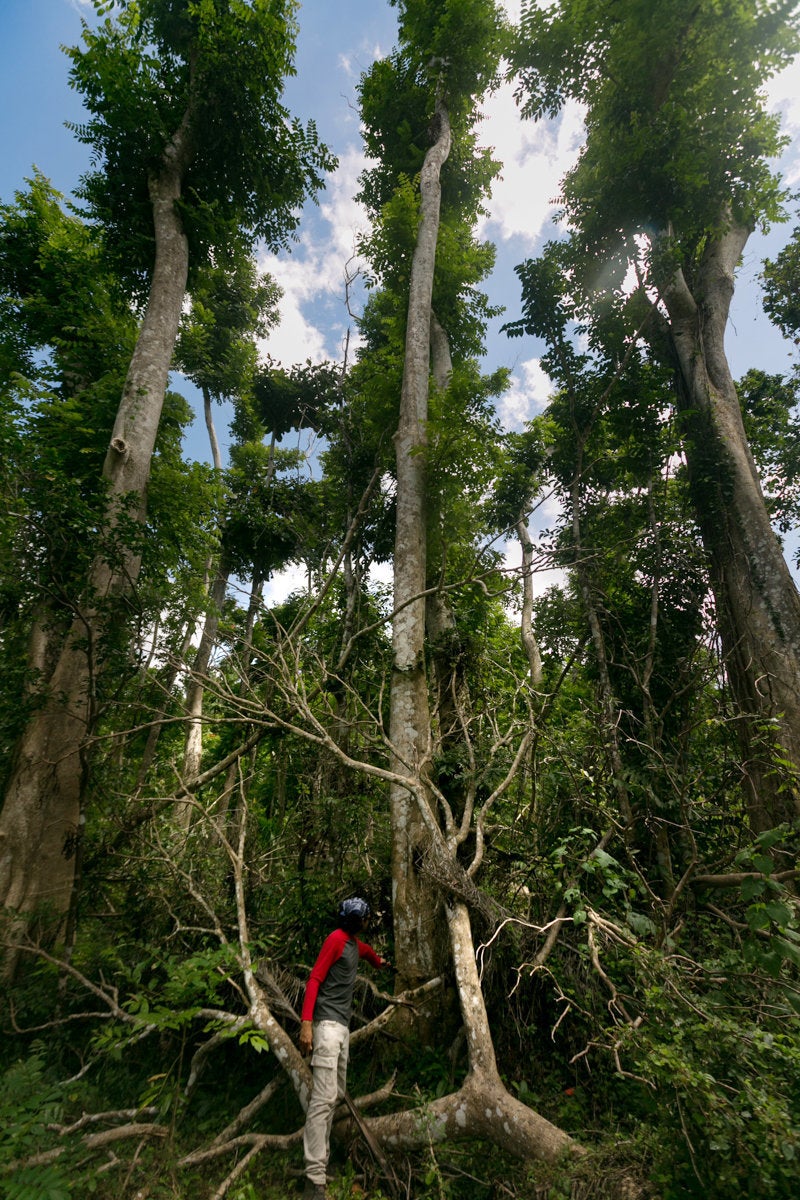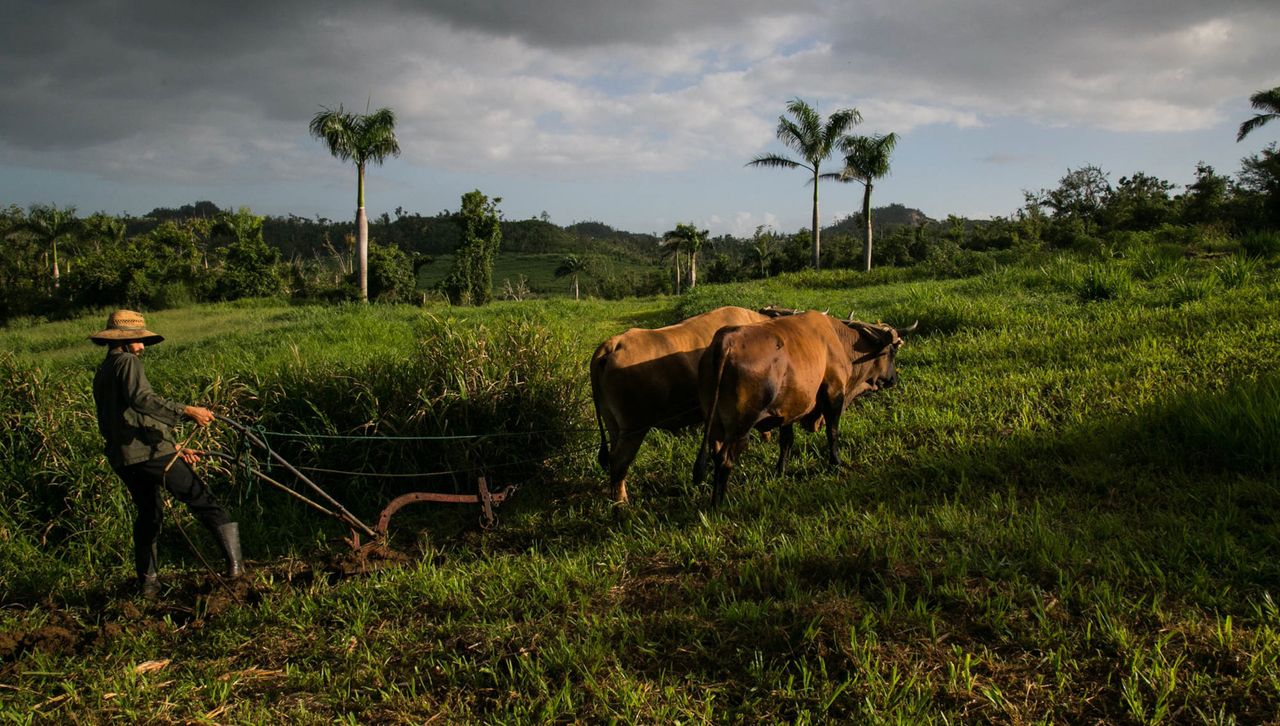Ian Pagán Roig went to bed on the night of Sept. 19, 2017, not knowing what his world would look like when he woke up.
The night before Hurricane Maria was set to make landfall, Pagán, a 29-year-old farmer in Toa Alta, Puerto Rico, faced crushing uncertainty. Hurricanes were not unusual in this part of the Caribbean, but a Category 5 storm was beyond many farmers’ experience. There was no one to ask for advice on how his farm, El Josco Bravo, might survive Maria’s intense and unrelenting wind speeds.
Pagán, a tall, gentle man with large brown hands, had tried to secure the farm. He dug trenches around his fields, removed the roof from his greenhouse and sheltered his two oxen, Caramelo and Josco, in his brother’s garage. He then took refuge in his concrete house, hoping that it would make it through the storm.
He’d never felt more vulnerable.
“You can’t do anything more. The hurricane’s coming,” he said. “You have to be humble.”
He awoke to a devastated landscape. A huge palm tree lay across the entrance to the farm and pools of water filled its valleys. The surrounding forest, stripped of every leaf, looked like a scattering of giant sticks jammed into the ground. There were pools of standing water from the intense rains. His land looked anything but ready for growing vegetables.
And yet one month after the storm, El Josco Bravo was once again producing crops.
Pagán rebounded quickly because he views his farm as an ecosystem, one that should be self-sufficient and resilient just like a natural Puerto Rican forest. It was no coincidence that his farm that imitated these qualities recovered quickly from Hurricane Maria.
Across the island, Puerto Rico’s forests outpaced many of the human systems in regrowth after the storm, and Pagán was not the only one watching. In places like El Yunque, the island’s 28,000-acre national forest, sun-loving plants quickly sprang up under the opened canopy, providing shade for other species and making way for the reformation of the forest structure. These natural systems, shaped by centuries of evolution and adaptation, knew how to rebuild after the disaster, but scientists in El Yunque and beyond still hope to gain new insight on how the ecosystem works and what humans can take away from it to prepare for the next big storm.
For many observing the island’s recovery, Maria offered one big lesson: When disaster strikes, it is nature itself that holds the best lessons on resilience.
‘A Toothpick Forest’
Forests are an integral part of Puerto Rico’s environment. They cover 60 percent of the island, shading urban and rural areas alike. Magnificent native palms, squat platano trees with elephantine leaves and orange-flowered, soft-barked African tulip trees populate the land with their vibrant green and tropical splendor.
In El Yunque National Forest, one of the oldest forest reserves in the Western hemisphere, the lush tree canopy stretches smoothly across the northeastern corner of the island. The thick foliage offers a shady respite to hikers wandering through the forest on a hot, sunny day.
That all changed after Maria. The 155 mph winds, rains and subsequent landslides damaged or killed an estimated 23 to 31 million trees across the island. The gusts ripped up smaller plants by the roots. The lush canopy and foliage disappeared overnight.

“It was a toothpick forest,” said Grizelle Gonzalez, a soil scientist at the International Institute of Tropical Forestry.
Gonzalez works in El Yunque and lives several kilometers north of the forest in the town of Luquillo. During the storm, she felt her house shake, and water came in horizontally through the metal shutters covering her windows. The sounds of growling, cracking and whistling surrounded her as Maria hit the Luquillo Mountains, one of Puerto Rico’s primary topographic barriers against storms.
This was not Gonzalez’s first hurricane. The 46-year-old, who wears bright pink lipstick with her muted tan and green U.S. Forest Service uniform, was also on the island for Hurricane Hugo in September 1989. But when she finally made it outside a day after Maria’s landfall, the sight of the decimated forest still shocked her.
“It was like a bomb hit,” she said. “It was like the temperate forest right before winter is coming, and it’s like, but I’m here!”
For Gonzalez, the completeness and intensity of the destruction in the forest was almost overwhelming. But deep down she knew it would recover, as it was adapted to do. Over the next few months, the forest would prove her right.
A System Tried And True
Right after Hurricane Maria, Ariel Lugo, the 75-year-old director of the International Institute of Tropical Forestry, went into the forest to take a picture. It was of a site, identifiable by data collection instruments, that he had been photographing since the day after Hurricane Hugo hit the island 28 years ago. He wanted to document the forest’s recovery timeline, and the post-Maria picture would be the last in the series, a way to bring the project full circle.
But he also went to check on one specific type of tree: the tabonuco.
Tabonuco trees grow on the ridges of mountains where the wind blows strongest. They are one of the tallest species in the forest, but despite their height, tabonucos hold their ground during storms that rip away their leaves. This is because of their interconnected root systems, Lugo said. An entire group of trees can be united and deeply entrenched in the ground. Though fallen trees littered the forest, Lugo wanted to see if the tabonucos were still standing.
They were.
The tabonucos are one example of a species that has taken adaptive measures to withstand Puerto Rico’s hurricane cycle. With intact root systems, the tabonucos can quickly restart water and nutrient uptake, and begin regrowing leaves.

Another resilient tree species is the Cecropia schreberiana, a pioneer species and one of the first to occupy a disturbed area. The post-hurricane landscape of open sky and bare ground provides a perfect nursery for its hardy seedlings. Cecropia can rapidly grow to 50 feet tall, and the shade cast by its giant leaves provides the optimal conditions for slow-growing, shade-tolerant species to take root beneath it.
In March, six months after the hurricane, the growth of Cecropia and other sun-lovers like ferns, grasses and shrubs was in full swing, and they dominated the forest floor. Trees rising above the bushy undergrowth sported tufts of leaves at their crowns and around their stubby branches. When the Cecropias die off, the understory clears and allows other plants to close the canopy.
In 10 to 15 years, the average person walking into El Yunque will not be able to tell that anything happened there, Lugo said. In 25 years, dead trees will be decomposed and recycled. The canopy will have fewer pioneer species and more slow-growers settled in. In 100 years, only scientific research and acute observation will be able to reveal the marks of the hurricane left after the forest’s incredible recovery system.
“For many observing the island’s recovery, Maria offered one big lesson: When disaster strikes, it is nature itself that holds the best lessons on resilience.”
“Nature has natural selection,” Lugo said. “If something doesn’t work, it gets eliminated and you get an alternate.”
While scientists like Lugo and Gonzales have been studying forests and hurricanes for decades, Maria’s strength and impact gives them new insights into the recovery process. It may also help them predict what may happen in future storms.
“If you can predict what’s going to happen fairly confidently, then you can take steps to manage it or tolerate it,” said Nicholas Brokaw, an environmental science professor at the University of Puerto Rico-Rio Piedras. “That’s our goal in science.”
In the past three months, the Forest Service has restored data collection equipment in the forest that Gonzalez said will be essential for observing and documenting the changes happening there during the recovery process.
“This is actually the first major hurricane that hit the whole island, and that we have the research infrastructure to really document,” she said.
Success At El Josco Bravo
Pagán’s farm, which recovered more quickly than most after the hurricane, offers a model for regrowth based on nature’s resilience. The young farmer, clad in tall rubber boots and a straw hat during his busy days at El Josco Bravo, attributed his success to three strategies.
One was his preparation for the storm, including removing his greenhouse roof and digging trenches. The winds blew through the empty skeleton of the greenhouse, and the trenches around his fields gathered the water and prevented erosion of the soil Pagán has spent three years cultivating. Pagán said other farmers failed to take these preventative measures partly out of complacency – the relative mildness of Hurricane Irma gave them false confidence, he said. But Pagán had too much at stake to take any chances.

His second strategy was his permanent infrastructure, mainly his greenhouse and his lake. These structures meant he didn’t have to spend time rebuilding his nursery or water supply. But his third strategy was most important, and it was his agroecological philosophy.
As a part of this philosophy, Pagán doesn’t rely on machinery, because it requires non-renewable fuel inputs that, in Puerto Rico, come in as imports. After the hurricane, other farmers waited in 10-hour lines to get gas to fill their tractors, but Pagán’s “tractors” ran on grass, and occupied themselves during the storm munching on breadfruit from a fallen tree nearby. On Oct. 3, two weeks after Maria, Pagán harnessed up his oxen and started ploughing his two acres of land.
Pagán also uses cover crops and makes compost from his neighbor’s yard waste to increase nutrients and water retention in his soil, which boost its fertility without the use of chemical fertilizers. Pagán, who did his master’s thesis at the University of Puerto Rico-Mayaguez on organic methods of soil recovery, could place his young crops in the rich brown earth as soon as they were big enough to come out of the greenhouse.
“Nature has natural selection. If something doesn’t work, it gets eliminated and you get an alternate.”
- Ariel Lugo
Pagán’s recovery paralleled that of El Yunque – both places built their regrowth on animals, sunlight, water and natural resources that didn’t need to come in from overseas. This is the result of agroecology, and Pagán saw his ability to produce food so quickly after the storm as evidence that his methods give farmers the tools to produce food even after great disturbances.
“The hurricane suddenly changed our reality,” said Pagán.
This combination of environmental systems and farming practices is what helped Pagán successfully survive Hurricane Maria, and it is what Gonzalez hopes Puerto Ricans see when they look at how the forest systems are continuously evolving.
“It’s important that people understand that these systems are very resilient,” she said. “Given the time to recover, the forest will respond positively.”
Photos and video by Alice Hudson, Gabi Palacio, Alexis Fairbanks and Kaitlin Harlow. Graphics by Elle Sommerville. With contributions from University of Puerto Rico students Hyam Colón, Denelys Estevez and David Ramos.
